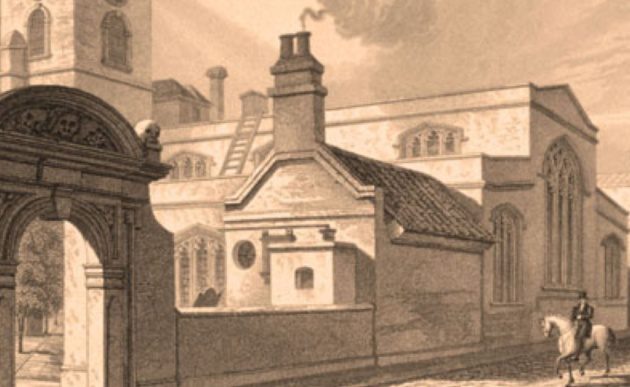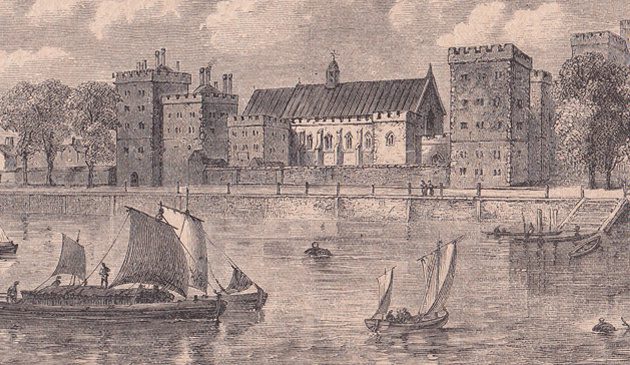Westminster Abbey in the Middle Ages

The magnificent chantry chapel of King Henry V. Henry died in 1422 and the chapel was completed in 1450, supervised by John Thirsk. Parts of the effigy were of silver but disappeared later in the 15th century. Other parts were stolen during the Reformation of the 1540s. The statuary depicts Henry as the king of both England and France.
The Benedictine monastery of St. Peter, what we know as Westminster Abbey, has been the venue for coronations of English monarchs since 1066. Work to transform the abbey into a Gothic masterpiece began in the 13th century and continued for over two hundred years. Unlike most cathedrals, it answered directly to the popes.
The earliest coronation at Westminster for which we have a detailed account is that of Richard II in 1377. The eleven-year-old processed through the streets from the Tower of London to Westminster, a custom that continued until Charles II in the 17th century. The ceremony was of such great length that at its end the young king had to be carried from the abbey on the shoulders of his tutor. Passing through the jostling crowd, one of Richard’s slippers, part of the sacred regalia, was lost. The painting of Richard that still hangs in the abbey, in his coronation robes and sitting in the coronation chair, is the earliest surviving portrait of an English monarch.
The Peasants’ Revolt took place in 1377, when the rebellious mob undertook massacre and much damage in and around London. Simon Sudbury, who had officiated at Richard’s coronation as Archbishop of Canterbury, was dragged to Tower Hill and beheaded. Richard Imworth, Steward of the Marshalsea Prison sought refuge at the shrine of Edward the Confessor in the abbey, but the mob dragged him away and he too was beheaded. King Richard visited Edward’s shrine later that day and prayed. The royal party then rode to Smithfield where the rebel leader, Wat Tyler, was killed.
A violent struggle took place in the abbey in 1378. During the campaigns of Edward, the Black Prince, two knights had taken an important prisoner, a friend of John of Gaunt. When they refused to free their valuable hostage John had them imprisoned in the Tower of London. They escaped and headed to the abbey to seek sanctuary. The Constable of the Tower pursued them with 50 men. A fight erupted during the middle of mass and one of the knights, Frank de Haule, his servant, and a monk, were left dead. The sanctuary of the abbey had been violated. De Haule was regarded as a martyr and buried in the south transept, perhaps the first to be buried there. The abbey was closed for months and Parliament suspended.
Richard’s wife, Anne of Bohemia, died of a plague in 1394. Richard summoned all the nobles to attend a procession and funeral mass at the abbey. The Earl of Arundel angered the King by arriving late and asking to be excused to deal with urgent matters. Richard seized a mace and struck Arundel, who fell to the floor. The service was then suspended due to Richard’s act of sacrilege.
Richard was not a successful king and eventually deposed, imprisoned by Henry Bolingbroke, and either murdered or starved to death. Bolingbroke was crowned at Westminster on St. Edward’s Feast Day 1399 as Henry IV. He created the Order of the Bath as recognition for those knights who formed the coronation procession from the Tower of London to the abbey. Richard was buried in Hertfordshire.
After Richard’s deposition the clergy were fearful of the loss of their pious royal patron and there was a plot to assassinate Henry IV. Monks of Westminster were incriminated and imprisoned at Ludgate but later released. Geoffrey Chaucer, author of the Canterbury Tales, was a royal servant and administrator during the reigns of Edward III, Richard II and Henry IV. As Collector of Customs and Clerk of Works to the Palace of Westminster he was favoured by Henry and granted a lease on a house in the abbey precincts, possibly to keep watch on the disaffected monks. Geoffrey died shortly after in 1400, however, and was buried in what was to become the Poets’ Corner of the abbey.
Henry was taken ill in 1413 at St. Edward’s shrine in the abbey while praying for safety on the eve of a crusade to the Holy Land. He died in the Jerusalem Chamber of the Abbots House. There are legends surrounding his death. One is that it fulfilled an earlier prophecy he would die in Jerusalem. Another, dramatized by William Shakespeare in King Henry IV, Part II, is that the future Henry V snatched the crown from his apparently dead father’s head in the Abbot’s House, only for the King to regain consciousness and say to his son “I commit all to God, and remember you to do well” before passing away. As a devotee of Thomas á Becket Henry chose to be buried at Canterbury Cathedral instead of Westminster, the only monarch to be buried there.
It was the ambition of Henry III that Westminster Abbey be rebuilt as a magnificent church to honour the shrine of his predecessor, Edward the Confessor. Work began in 1245. The construction of the new building was only partly completed by the time of his death. Finance and enthusiasm became exhausted during the reign of his son, Edward I, and the abbey’s renewal was to last for many generations. Simon Langham, an abbot of Westminster who rose to great office and died in 1376, left a fortune in his will towards the work. Richard II was also a major sponsor and during his reign the magnificent Jerusalem Chamber, the state apartment of the abbot, was completed in 1380. The royal mason Henry Yevele, who carried out work on the Palace of Westminster and Tower of London, oversaw work in the 1390s and built the nave arcade.


